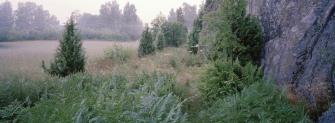Traditional rural biotopes

The remaining traditional rural biotopes are nowadays often reduced to small-sized parcels, but nonetheless they are essential for biodiversity. Numerous endangered species of plants, insects and fungi are dependent on them. Traditional rural biotopes also belong to the most endangered habitat types in Finland. Preserving the remaining traditional rural biotopes has become one of Finland’s most difficult conservation issues.
Traditional rural biotopes declined in Finland sharply in the early 1900s, in the course of the rapid development of agricultural technology. Nowadays only a few percent of the previous one million hectares of semi-natural grasslands and wooded pastures remain.
Maintaining the traditional rural biotopes is based on continuous grazing or mowing, which enables the numerous species of open habitats to flourish. After the management of these habitats has ended, the flowering plants are soon replaced by grasses and bushes. Eventually the former meadow will turn into a closed forest, and its natural, aesthetical and cultural values are being lost.
Photographed sites
Since 2001, visual monitoring of traditional biotopes has been carried out in a total of 48 regions in Uusimaa and Pirkanmaa. In Finnish language version of the page we present photographs from 18 traditional rural biotopes which are numbered on the map below.
